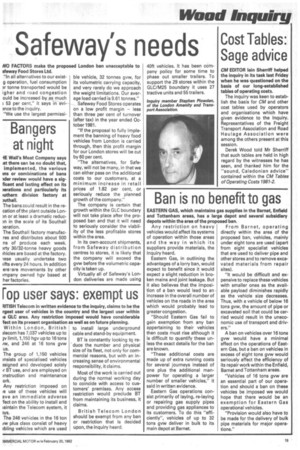Safeway's needs
Page 13

If you've noticed an error in this article please click here to report it so we can fix it.
"In all alternatives to our existg operation, fuel consumption ar tonne transported would be igher and road congestion ould be increased by as much
53 per cent," it says in-evi-ance to the inquiry.
"We use the largest permissi ble vehicle, 32 tonnes gvw, for its volumetric carrying capacity, and very rarely do we approach the weight limitations. Our average load carried is 9.61 tonnes." — Safeway Food Stores operates on a low profit margin — less than three per cent of turnover (after tax) in the year ended October 1981.
"If the proposal to fully implement the banning of heavy food vehicles from London is carried through, then this profit margin for our London stores will be cut by 60 per cent.
"The alternatives, for Safeway, will not be many, in that we can either pass on the additional costs to our customers) at a minimum increase in retail prices of 1.82 per cent, or seriously reduce the planned growth of the company."
The company is certain that growth within the GLC boundary will not take place after the proposed ban and that it will need to seriously consider the viability of the less profitable stores within the area.
In its own-account shipments, from Safeway distribution centres to stores, it is likely that the company will exceed the gvw before the volumetric capacity is taken up.
Virtually all of Safeway's London deliveries are made using 40ft vehicles. It has been cornpany policy for some time to phase out smaller trailers. To support the 29 stores within the GLC/M25 boundary it uses 27 tractive units and 55 trailers.


















































